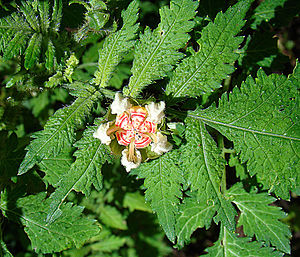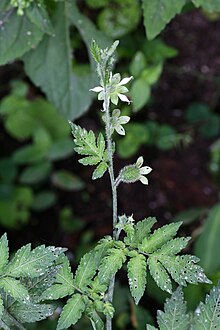Nasa (genus)
| NASA | ||||||||||||
|---|---|---|---|---|---|---|---|---|---|---|---|---|

|
||||||||||||
| Systematics | ||||||||||||
|
||||||||||||
| Scientific name | ||||||||||||
| NASA | ||||||||||||
| Little |
Nasa is a genus of plants withinthe nettle family (Loasaceae). With around 100 species spread from Central to South America, it is the most species-rich genus of the Loasaceae family.
description

Vegetative characteristics
At Nasa TYPES is shrubs , half-shrubs or annual to perennial herbaceous plants reach stature heights from 5 to 400 centimeters. The primary root gradually recedes as it grows ; in fully grown plants, only adventitious roots can be found that grow from the trunk that lies on the ground. The above-ground parts of the plant are covered with nettle hair.
The leaves are arranged opposite or alternate. The leaf blades are ovate or circular and lobed, palmate or pinnate to multiply pinnate, sometimes umbrella-shaped.
Generative characteristics
The terminal inflorescences are thyrsenic with dichasic or monochasic . Under each flower there is a recalculating bract .
The hermaphrodite flowers are radially symmetrical with a double flower envelope . The petals are white, yellow, orange or red and often two-colored. The outer staminodes are fused and form a scale leaf ( nectar scale ), on the back of which there are up to three calli , which, however, can also be winged at the tip and provided with nectar bags on the outer side. The inner staminodes are L-shaped, at their base there are occasional outgrowths. The placentas are simple.
The capsule fruits are cylindrical to round and open with three to five flaps at the top of the fruit. The seeds are egg-shaped, round or slightly angular.
Chromosome sets and ingredients
The number of chromosomes is 2n = 28 or 56.
The seeds of the NASA species have high levels of pharmaceutically interesting fatty acids ( gamma-linolenic acid and stearidonic acid ).
Occurrence
The genus Nasa has its center of diversity in Colombia, Peru and Ecuador. A few species are also found in Chile, Bolivia and Venezuela as far as Central America and southern Mexico. The majority of Nasa species thrive in cloud forests, some species are weeds on cultivated land, but a few also in semi-deserts, coastal forests, rain forests and other zones.
Systematics
In 1997, after extensive systematic work on the Loasaceae family in Maximilian Weigend's doctoral thesis, it was determined that a new genus is required for a large number of species that were previously classified under Loasa ; it was published by NASA , albeit invalid, in Nasa and the Conquest of South America , page 214. The genus Nasa was only published in 2006 in Taxon , Volume 55, Issue 2, page 465. Type species is Nasa rubrastra (Weigend) Weigend (Syn .: Loasa rubrastra Weigend ).
The genus Nasa belongs to the tribe Loaseae in the subfamily Loasoideae within the family Loasaceae .
The genus Nasa contains around 100 species:
- Nasa aequatoriana (Urb. & Gilg) Weigend
- Nasa anderssonii Weigend
- Nasa aspiazui (Macbr.) Weigend
- Nasa bicornuta (Weigend) Weigend
- Nasa campaniflora (Triana & Planchon ex Urb. & Gilg) Weigend
- Nasa carnea (Urb. & Gilg) Weigend
- Nasa carunculata (Urb. & Gilg) Weigend
- Nasa chenopodiifolia (Desr.) Weigend
- Nasa colanii Dostert & Weigend
- Nasa cuatrecasasii Weigend
- Nasa dillonii Weigend
- Nasa dolichostemon (Urb. & Gilg) Weigend
- Nasa driesslei Weigend
-
Nasa dyeri (Urb. & Gilg) Dostert & Weigend : There are two subspecies:
- Nasa dyeri (Urb. & Gilg) Dostert & Weigend subsp. dyeri
- Nasa dyeri subsp. australis Dostert & Weigend
- Nasa ferruginea (Urb. & Gilg) Weigend
- Nasa glabra (Weigend) Weigend
- Nasa grandiflora (Desr.) Weigend
- Nasa hastata (Killip) Not available
- Nasa hornii (Weigend) Weigend
-
Nasa humboldtiana (Urb. & Gilg) Weigend : There are four subspecies:
- Nasa humboldtiana (Urb. & Gilg) Weigend subsp. humboldtiana
- Nasa humboldtiana subsp. obliqua Dostert & Weigend
- Nasa humboldtiana subsp. roseoalba (Weigend) Dostert
- Nasa humboldtiana subsp. tricolor Dostert & Weigend
- Nasa jungifolia (Weigend) Weigend
- Nasa karsteniana (Urb. & Gilg) Weigend
- Nasa laxa (Macbr.) Weigend
- Nasa lehmanniana (Urb. & Gilg) Weigend
- Nasa lenta (Macbr.) Low
- Nasa limata (Macbr.) Weigend
- Nasa loxensis (Kunth) Weigend
- Nasa macrantha (Urb. & Gilg) Weigend
- Nasa macrorrhiza (Urb. & Gilg) Weigend
- Nasa macrothyrsa (Urb. & Gilg) Weigend
- Nasa magnifica (Urb. & Gilg) Weigend
- Nasa nubicolorum Weigend
- Nasa olmosiana J.F. Macbr . (Weigend) PMJoergensen & S. León-Y.
- Nasa orbicularis Weigend
- Nasa pascoensis Weigend
- Nasa peltata (Urb. & Gilg) Weigend
- Nasa peltiphylla (Weigend) Weigend
- Nasa perijensis (Weigend) Weigend
-
Nasa picta (Hook.) Weigend : There are two subspecies:
- Nasa picta subsp. pamparomasii Weigend & Rodriguez
- Nasa picta (Hook.) Weigend subsp. picta
- Nasa pilovena Weigend
- Nasa poissoniana (Urb. & Gilg) Weigend
- Nasa profundilobata (Werderm.) Weigend
- Nasa profundiserrata Weigend
-
Nasa pteridophylla Weigend & Dostert : There are two subspecies:
- Nasa pteridophylla Weigend & Dostert subsp. pteridophylla
- Nasa pteridophylla subsp. geniculata Weigend & Dostert
- Nasa puma-chini (Weigend) Weigend
- Nasa puracensis (Blake & Killip) Low
- Nasa raimondii (Standley & Barkley) Weigend
- Nasa ramirezii (Weigend) Weigend, PMJoergensen & S. León-Y.
- Nasa ranunculifolia (Kunth) Weigend
- Nasa rubrastra (Weigend) Weigend
- NASA rufipila Weigend
- Nasa rugosa (Killip) Low
- Nasa sagastegui Weigend
- Nasa santa-martae (Weigend) Weigend
- Nasa schlimiana (Planchon & Triana) Weigend
- Nasa solaria (Macbr.) Weigend
- Nasa solata (Macbr.) Weigend
- Nasa stuebeliana (Urb. & Gilg) Weigend
- Nasa tingomariensis (Macbr.) Weigend
- Nasa trianae (Urb. & Gilg) Weigend
-
Nasa triphylla (Juss.) Weigend : There are eight subspecies:
- Nasa triphylla subsp. colonchensis Weigend
- Nasa triphylla subsp. elegans Dostert & Weigend
- Nasa triphylla subsp. flavipes Weigend & Dostert
- Nasa triphylla subsp. loxensis Dostert & Weigend
- Nasa triphylla subsp. lutescens Weigend & Dostert
- Nasa triphylla subsp. papaverifolia (Kunth) Weigend
- Nasa triphylla subsp. rudis (Benth.) Little
- Nasa triphylla (Juss.) Weigend subsp. triphylla
- Nasa urens (Jacq.) Weigend
- Nasa urentivelutina Weigend
- Nasa vargasii (Macbr.) Weigend
- Nasa weberbaueri (Urb. & Gilg) Weigend
proof
literature
- Maximilian Weigend: Loasaceae. In: Klaus Kubitzki (Ed.): The Families and Genera of Vascular Plants . Volume 6: Flowering Plants, Dicotyledons: Celastrales, Oxalidales, Rosales, Cornales, Ericales . Springer, Berlin / Heidelberg / New York 2004, ISBN 3-540-06512-1 , pp. 248 (English, limited preview in Google Book search).
- Maximilian Weigend: Familial and generic classification , online at the FU Berlin. , last accessed on September 25, 2017
Individual evidence
Most of the information in this article has been taken from the sources given under references; the following sources are also cited:
- ↑ K. Aitzetmüller et al .: Seed Oil Fatty Acids of Loasaceae. In: J. Amer. Oil Chem. Soc. Volume 81, 2004, pp. 259-263.
- ↑ International Code Of Botanical Nomenclature (Vienna Code), Art. 30.5, Ex. 10, Online
- ^ Nasa at Tropicos.org. Missouri Botanical Garden, St. Louis, Retrieved September 25, 2017.
- ^ Nasa in the Germplasm Resources Information Network (GRIN), USDA , ARS , National Genetic Resources Program. National Germplasm Resources Laboratory, Beltsville, Maryland. Retrieved September 25, 2017.
- ↑ Maximilian Weigend: Familial and generic classification , online at the FU Berlin. , last accessed on September 25, 2017

